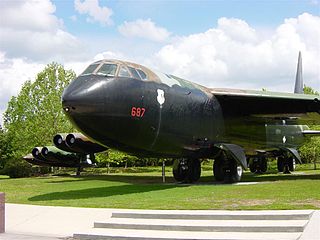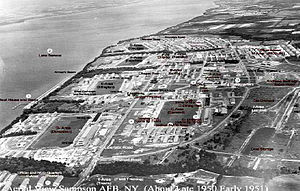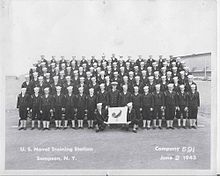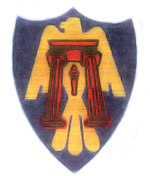
Military recruit training, commonly known as basic training or boot camp, refers to the initial instruction of new military personnel. It is a physically and psychologically intensive process, which resocializes its subjects for the unique demands of military employment.

Lackland Air Force Base is a United States Air Force (USAF) base located in Bexar County, Texas, United States. The base is under the jurisdiction of the 802d Mission Support Group, Air Education and Training Command (AETC) and an enclave of the city of San Antonio. It is the only site for USAF and United States Space Force enlisted Basic Military Training (BMT).

Randolph Air Force Base is a United States Air Force base located at Universal City, Texas.

McCoy AFB is a former U.S. Air Force installation located 10 miles (16 km) southeast of Orlando, Florida. It was a training base during World War II. From 1951 to 1975, it was a frontline Strategic Air Command (SAC) base during the Cold War and Vietnam War. It was Orlando's biggest employer and economic backbone prior to the opening of Walt Disney World in 1971.

Lowry Air Force Base is a former United States Army Air Forces (USAAF) training base during World War II and a United States Air Force (USAF) training base during the Cold War. From 1955-1958, it served as the initial site of the U.S. Air Force Academy. It is a U.S. Formerly Used Defense Site (B08CO0505).

The Air Education and Training Command (AETC) is one of the nine Major Commands (MAJCOM) of the United States Air Force (USAF), reporting to Headquarters, United States Air Force. It was established 1 July 1993, with the realignment of Air Training Command and Air University.

Sampson State Park is a 2,070-acre (8.4 km2) state park located in Seneca County, New York. The park is south of the city of Geneva in the Town of Romulus on the east shore of Seneca Lake, one of the Finger Lakes.

The Air Training Command (ATC) is a former United States Air Force (USAF) Major Command designation. It was headquartered at Randolph Air Force Base, Texas, but was initially formed at Barksdale Air Force Base, Louisiana. It was re-designated as Air Education and Training Command (AETC) following a merger with Air University (AU) on 1 July 1993.

Parks Reserve Forces Training Area (PRFTA), commonly known as Camp Parks, is a United States Army base located in Dublin, California, that is currently an active military and training center for U.S. Army Reserve personnel to be used in case of war or natural disaster.

Chanute Air Force Base is a decommissioned United States Air Force facility, located in Champaign County, Illinois, south of and adjacent to Rantoul, Illinois, about 130 miles (210 km) south of Chicago. Its primary mission throughout its existence was Air Force technical training. Chanute Field was established on 21 May 1917, being one of thirty-two Air Service training camps established after the United States entry into World War I.

Ellington Field Joint Reserve Base is a joint installation shared by various active component and reserve component military units, as well as aircraft flight operations of the National Aeronautics and Space Administration (NASA) under the aegis of the nearby Johnson Space Center. The host wing for the installation is the Texas Air National Guard's 147th Attack Wing. Opened in 1917, Ellington Field was one of thirty-two Air Service training camps established after the United States entry into World War I. It is named for First Lieutenant Eric Ellington, a U.S. Army aviator who was killed in a plane crash in San Diego, California in 1913.

Graham Air Base was a United States Air Force base located in Marianna, Florida. After it was closed in 1960, it was reused as Marianna Municipal Airport.

Greenville Air Force Base is a former United States Air Force base in Greenville, Mississippi. It was closed as a military installation in December 1966 and redeveloped into Mid-Delta Regional Airport.

Anniston Air Force Base is a former United States Air Force airfield located approximately 10 miles north-northeast of Talladega, Alabama. It was active from 1942 to 1945 and 1949 to 1952. It is currently the site of the Talladega Superspeedway and Talladega Municipal Airport.

Eagle Pass Army Airfield is a former World War II military airfield complex. It is located 10.6 miles (17.1 km) north of Eagle Pass, Texas. It operated as a training base for the United States Army Air Forces from 1943 until 1945.

Gulfport Combat Readiness Training Center is a United States Air Force training center, located at Gulfport-Biloxi International Airport, Mississippi. It is located 5 miles (8.0 km) north-northeast of Gulfport, Mississippi.
Seneca Army Airfield is a closed facility of the United States Army that was originally built as the operational field for Sampson Air Force Base around 1953. Following the closure of the base, the field was turned over to the Army and became part of the nearby Seneca Army Depot. During this time, it was loosely controlled by the Army, as patrols reported seeing civilian aircraft on the runways. Around 1965, the airport reverted to civilian control, although this period was brief and it was converted back to military control soon after. The airport closed by 2000, when the nearby depot closed due to recommendations from the 1995 Base Realignment and Closure Commission.

Webb Air Force Base, previously named Big Spring Air Force Base, was a United States Air Force facility of the Air Training Command that operated from 1951 to 1977 in West Texas within the current city limits of Big Spring. Webb AFB was a major undergraduate pilot training (UPT) facility for the Air Force, and by 1969, almost 9,000 pilots had been trained at Webb. The last operational wing at Webb AFB was the 78th Flying Training Wing.

Harlingen Air Force Base, originally Harlingen Army Airfield, is a former United States Air Force (USAF) base in northeast Harlingen, Texas. After the base closed, the field was redeveloped into Valley International Airport.

























